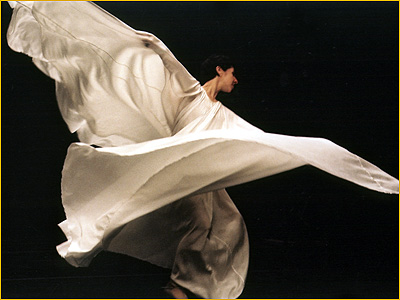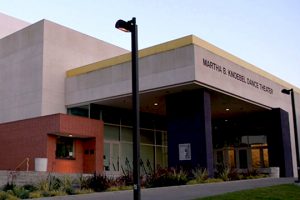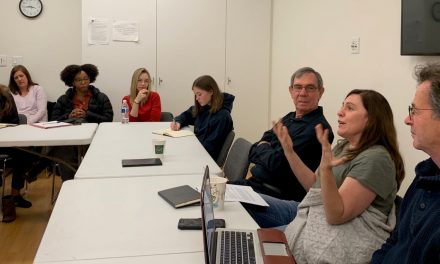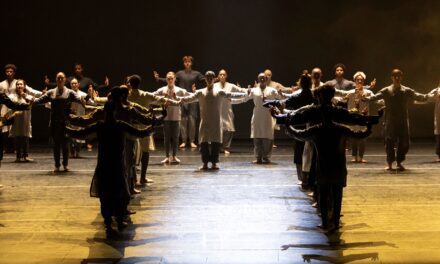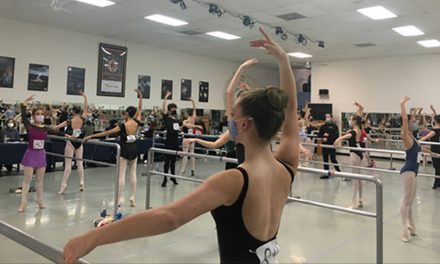California State University, Long Beach (CSULB) is known as the Arts University of the CSU system. Founded in the early 1970s, the Department of Dance has become a leading dance department nationwide. The woman who led the department for 31 years was the extraordinarily foresighted and resourceful Dr. Joan Schlaich. Over the years several others have held the title Chairperson including Pat Finot, Judy Allen, Cyrus Parker-Jeannette, Susan McLain, and Andrew Vaca. The department was the first in California to offer a B.A. in Dance and now offers B.A., B.F.A, M.A. and M.F.A degrees. The department has been accredited by the National Association of Schools of Dance (NASD) since 1982.
Betsy Cooper is currently in her second semester as Professor and Chairperson of the Department of Dance. As Professor Emeritus, I was interested in learning more about her dance and academic background, and what, if any, changes were under consideration for the department.
Having always been curious as to when a dancer received the terpsichorean call from the Goddess of dance and what series of events lead her/him to a particular dance style or company, I began by asking knowing that she has enjoyed both a professional performing career in ballet and contemporary dance, plus working as faculty member, director of dance programs, and as dean, I asked Ms. Cooper to provide some background of where she grew up and received her early dance training.
Born at New York Hospital, she was raised on Long Island. Memories of her first dance teacher were that the woman had trained in Cecchetti Ballet and may have studied with modern dance pioneer Charles Weidman. Like many young dancers, Cooper had an eclectic background, training in ballet, pointe work, Graham and Jazz. What she learned most from that first teacher was a strong passion for dance.
Because of her proximity to New York City, Cooper had many opportunities to study in professional schools. At age 12 she received a scholarship to the Alvin Ailey School of Dance studying Graham and Lester Horton techniques, ballet and jazz. At 15 she was going back and forth between the Ailey school and the American Ballet Theater School, plus attending summer dance programs.
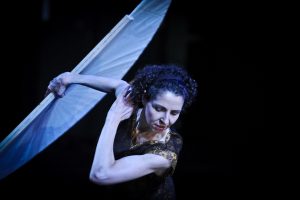
Betsy Cooper in “Planes In Air” Choreography Molissa Fenley – Photo: Gabriel Bienczychi Zebra Visual
Coincidentally, one of Cooper’s favorite dancers was Rebecca Wright who, at the time, was dancing with the Robert Joffrey Ballet. Wright would later become a professor in the CSULB Department of Dance. It was, however, a summer at the New York State Summer Arts program where Cooper saw her first performance of the New York City Ballet (NYCB) which led to five years of training at the School of American Ballet (SAB) and dreams of performing with the company. Her years at SAB involved extensive performance opportunities: children’s roles with NYCB, featured roles with NYCB’s Dance Education Lecture Demonstration program under the directorship of Suki Schorer, SAB annual workshop performances and in premieres by Peter Martins and Balanchine in the NYCB’s Tschaikovsky (1981) and Stravinsky (1982) Festivals.
Her first professional job was dancing in the corps de ballet of Makarova and Company, directed by the world-famous ballerina Natalia Makarova. The company performed in a Broadway theater with guest appearances by principal dancers of that era; a list that included Fernando Bujones, Anthony Dowell, Karen Kain, Cynthia Gregory, and Peter Schaufuss. Impressed with her dancing, Makarova had Cooper learn a pas de trois with Cynthia Gregory and Paquita pas de trois with Fernando Bujones and Nancy Raffa. This, of course, meant extra rehearsals outside those with the corps.
Due to the extra work, Cooper suffered a stress fracture that would not heal and was forced to take time off from dancing. Balanchine was still director of New York City Ballet, and the event that altered the direction of her life was when he was admitted into a hospital and never came out. It was 1983. “That was my year.” Cooper said. It was when her SAB cohort were being considered for apprenticeship for the company. As a result of Balanchine’s long hospitalization, no apprentices were chosen that year. The man chosen to take over as director of NYCB was Peter Martins.
“I think it was the combination of being injured, being in pain, and the devastating sense of loss and grief of Balanchine’s death.” Cooper said. “I wasn’t thinking of other options like going to American Ballet Theatre or San Francisco Ballet where I had studied. I just quit. I quit dancing.”
It was after reading Winter Season: A Dancer’s Journey by Toni Bentley in which she wrote about her own experience with leaving dance, that Cooper gathered up the courage to make a change. As a young girl, her family had traveled to Egypt and Greek, and so she was always interested in two ancient histories. Her family’s home was filled with books on art and history, plus she had grown up wandering around inside museums in New York City. So, it is not actually surprising that, at age 21, Cooper found herself at Yale University studying Archeology. “The thing about archeology,” she said. “is that you take all these art history and archeology classes, but you were also required to do archeological fieldwork—to dig. It was very physical, you got dirty and there was a lot of comradery.” Cooper compared it to dancers working together in class or rehearsals where they also get sweaty and exhausted working closely with one another.
“It was amazing!” Cooper said enthusiastically. “I love learning.” After graduating with a BA, cum laude, in Archeological Studies and her injury healed, she said with a smile. “I returned to dancing.” This time, however, Cooper concentrated on contemporary ballet and, at 26, found herself experiencing the downtown NYC dance scene, going to auditions and, unlike what she characterized as “a dream career”, discovered what life was like for most dancers. It was a life of going to cattle call auditions, doing pick-up project work and having to travel to other places to find steady work.
She got a job working with the National theatre of Mannheim in Germany and began teaching some community classes. She had been teaching since the age of 18, but said that at that young age, one does not have a lot to say. At 30, however, Cooper did and discovered that she really enjoyed teaching.
After Germany she also lived and worked in Canada but ended up receiving her MFA in Dance at the University of Washington (UW) in Seattle where she eventually returned to work.
From 2001 to 2013 she was the Director of the Dance Program at UW and for three years (2012-2015) served as Divisional Dean of Arts in the College of Arts & Sciences at UW. She was a recipient of the 2004 Distinguished Teaching Award and the Thomas L. and Margo G. Wyckoff Endowed Faculty Fellowship. Under her leadership, The UW Dance Program was honored with the 2002 Brotman Award for Instructional Excellence.
While Dean at UW, Cooper was asked to perform a review of the dance program at Mills College. It was then that she first met dancer, choreographer Molissa Fenley, and later, while performing with Seattle Dance Project, Fenley was hired to choreograph a work for the company. Fenley chose to convert a trio of hers into a duet. Cooper was cast in the work and she found that she loved dancing Fenley’s work. They became friends and Cooper continues to perform with Molissa Fenley and Company.
Reading her resume, one sees that over span of her academic career Cooper has published numerous research papers, so I asked her about her interest in research.
“I grew up in a house with books, heated conversation and debate where I was taught to think critically.” She said. “Yes! And talking about politics.” Her father was a history major before he became a doctor and he was interested in science and art. Her mother was very creative and so, between the two of them, she was fortunate enough, as previously mentioned, to visit many art and history museums. “My father was a natural teacher.” She said and he taught her to look at art in a very analytical way. “With love.” She said with a smile, adding that while growing up, learning became a release from the stress caused by her intense dance training.
During her archeology studies, she was involved in investigative work and going through archives. “I became very interested in writing about things that do not exist anymore.” She said and enjoyed writing about buildings or artifacts that were no longer around. Piecing together the history of extinct things, combined with a curiosity of the investigative process, she discovered that it was a natural segue into writing about dance history. Cooper had learned about the Works Projects Administration’s (WPA) Dance Projects that were started under the Franklin D. Roosevelt administration from her parents who had grown up during the depression. It was a program that sadly lost its funding during the second Red Scare as a result of the House Un-American Activities Act.
Cooper became absorbed in that period, writing about Helen Tamaris, Charles Weidman and Ruth Page in Chicago and other choreographers who were involved in politics and whose work basically no longer exists.
When I asked Cooper, why she left her job in Washington, she stressed that she had really loved working with her colleagues in the Dance Program and dean’s office at UW, but that situations in her personal life dictated that she move on. “I needed to go home.” She said softly. “I missed New York and I needed something to in my life to shift.” She got a job at Hunter College in New York City, but found that it was not a good fit. Next, she became Dean of the Hartt School, a performing arts conservatory within the University of Hartford in Connecticut. “It was not New York, but it was very close to Jacob’s Pillow.”
Wanting to get back to working in public higher education, she again entered the job market and came across the opening at CSULB. She had heard about the department and knew it to be a prestigious program. “And you can’t beat the facilities!” She said.
The Dance Center at CSULB has seven spacious dance studios, one traditional classroom, one half classroom/half studio, video production iMac computer lab, audio recording studio, Pilates lab and classroom, dance clinic, student only lounge, faculty only lounge, the Martha Knoebel Dance Theater with green room and spacious dressing rooms, a large and fully equipped costume shop, and a separate building for faculty offices. It is a building that Dr. Schlaich dreamed of and worked for her entire tenure at CSULB, and it is a facility that is the envy of many dance departments throughout the country.
During her interview for the Chair position, Cooper observed that the dance faculty was very engaged in running the department, invested in its degrees and dedicated to working with the students. “I still believe that public higher education is the engine of social mobility.” She said. “And these students really need our support.” Cooper feels that CSULB is a good place for her, and the department fits well with her values. She added that everyone in the Dean’s Office has always been tremendously supportive.
One of my final questions to Ms. Cooper was, given the history of the department, what was her vision regarding the direction that it needed to go. “I think that my vision involves all of the students who study here.” She answered. “I’m a firm believer that it is not necessarily the degree; the BA, BFA, BS etc., that makes a professional dancer. Obviously it is the curriculum and the faculty that you bring, but in the end, it is up to the dancer. Someone with a degree in English, for example, could go on to become a professional dancer.”
“I came into the interview process as a listener.” Cooper continued. “I listened to the faculty and what I heard was that they have this strong BFA, but that they wanted to revise the BA, the Bachelor of Arts.” She explained that their reasonings sounded important and timely, and that the department is now focused on re-envisioning its BA program. “It is no longer the 1970s, ‘80s or 90s, but 2019.” Cooper stressed. “The world and the dance scene have changed, and the department needs to focus on what the students are currently interested in and what they need.”
They all agree that ballet and modern dance remain important aspects of the core curriculum because many companies still use those techniques as a base, but the faculty believes that they now need to bring other dance forms into the degree’s core classes. Indeed, as a reviewer, I see that many dance companies incorporate a fusion of ballet, modern, contemporary dance, jazz and hip-hop styles. The faculty at CSULB are also accepting more students into the department who show an interest in the dance sciences such as physical therapy, Pilates, athletic training and Gyrotonics. The course work and the facility to support this idea are already in place, so the department hopes to become the first school in the CSU system to offer a BS Degree in Dance Science.
Cooper thinks that it is not enough for only one person to have a vision for the department. She wants to educate the students in such a way as to give them the opportunity to go out into the dance field and become as successful as possible. She is listening to the faculty about what they want and looking at what each has to offer. There are four senior Full Professors and four Assistant Professors who are part of the emerging dance scene, plus numerous part time lecturers who are active in various aspects of the field. The faculty do not all think alike, nor do they approach teaching in the same way and Cooper finds it an interesting environment in which to work.
We discussed how working in a university has changed and what the challenges are, i.e. funding, the push for students to graduate in four years even though they are also working full time jobs, and how some government officials believe that higher education should not be afforded to everyone. “It [the university] used to be a place where one came to explore, figure things out and learn for the love of learning and discovery.” She said. “I think that is still inherent in dance. I know that it is!”
As the interview concluded, Cooper expressed how it is not just her vision for the department but a mandate to help the students succeed in their visions and ambitions.
For more information about the CSULB Department of Dance, the Dance Center and its faculty, click here.
Featured image: Betsy Cooper in “Planes In Air” Choreography Molissa Fenley – Photo: Gabriel Bienczychi Zebra Visual

